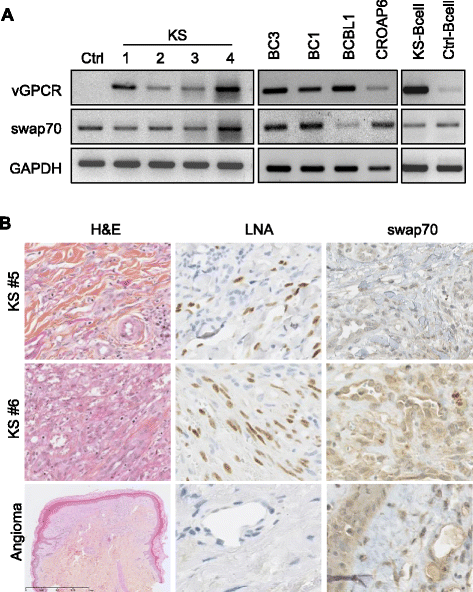The guanine exchange factor SWAP70 mediates vGPCR-induced endothelial plasticity
- PMID: 25889342
- PMCID: PMC4336709
- DOI: 10.1186/s12964-015-0090-1
The guanine exchange factor SWAP70 mediates vGPCR-induced endothelial plasticity
Abstract
Background: The viral G protein-coupled receptor (vGPCR) is proposed to act as one of the predominant mediators of Kaposi's sarcoma (KS), a human herpes virus 8 (HHV8)-elicited disease. The actions of vGPCR manifest pathogenesis, in part, through increased permeability of endothelial cells. Endothelial cell-cell junctions have indeed emerged as an instrumental target involved in the vasculature defects observed within the tumor microenvironment. The pathway leading to adherens junction destabilization has been shown to involve the activation of the small GTPase Rac, in the context of either latent infection or the sole expression of vGPCR. However, the precise molecular mechanisms governed by vGPCR in vascular leakage require further elucidation.
Findings: Guanine exchange factors (GEFs) function as critical molecular switches that control the activation of small GTPases. We therefore screened the effects of 80 siRNAs targeting GEFs on vGPCR-driven endothelial permeability and identified switch-associated protein 70 (SWAP70) as necessary for its elevating effects. Pull-down experiments further showed that Rac activation by vGPCR was dependent on SWAP70. Examination of tissues and cells from HHV8-positive patients revealed that SWAP70 was ubiquitously expressed. Furthermore, SWAP70 was found to be crucial for vGPCR-driven endothelial tube formation and endothelial sprouting in vitro.
Conclusions: SWAP70 appears to act as a molecular intermediate between vGPCR and endothelial activation. Because of the important role of vGPCR-mediated endothelial plasticity in KS pathogenesis, inhibition of SWAP70 function could be of interest for blocking vGPCR-driven activities in HHV8-defined diseases.
Figures




Similar articles
-
Activation of proMMP-2 and Src by HHV8 vGPCR in human pulmonary arterial endothelial cells.J Mol Cell Cardiol. 2007 Mar;42(3):517-25. doi: 10.1016/j.yjmcc.2006.08.004. Epub 2006 Dec 26. J Mol Cell Cardiol. 2007. PMID: 17188706
-
The Kaposi's sarcoma-associated herpesvirus G protein-coupled receptor as a therapeutic target for the treatment of Kaposi's sarcoma.Cancer Res. 2006 Jan 1;66(1):168-74. doi: 10.1158/0008-5472.CAN-05-1026. Cancer Res. 2006. PMID: 16397229
-
RBP-J (CSL) is essential for activation of the K14/vGPCR promoter of Kaposi's sarcoma-associated herpesvirus by the lytic switch protein RTA.J Virol. 2004 Jul;78(13):6818-26. doi: 10.1128/JVI.78.13.6818-6826.2004. J Virol. 2004. PMID: 15194757 Free PMC article.
-
Emerging targets and novel strategies in the treatment of AIDS-related Kaposi's sarcoma: bidirectional translational science.J Cell Physiol. 2006 Dec;209(3):659-62. doi: 10.1002/jcp.20795. J Cell Physiol. 2006. PMID: 17001705 Review.
-
Molecular mechanisms deployed by virally encoded G protein-coupled receptors in human diseases.Annu Rev Pharmacol Toxicol. 2013;53:331-54. doi: 10.1146/annurev-pharmtox-010510-100608. Epub 2012 Oct 22. Annu Rev Pharmacol Toxicol. 2013. PMID: 23092247 Free PMC article. Review.
Cited by
-
Glioblastoma stem-like cells secrete the pro-angiogenic VEGF-A factor in extracellular vesicles.J Extracell Vesicles. 2017 Aug 8;6(1):1359479. doi: 10.1080/20013078.2017.1359479. eCollection 2017. J Extracell Vesicles. 2017. PMID: 28815003 Free PMC article.
-
The E3 ubiquitin ligase MARCH3 controls the endothelial barrier.FEBS Lett. 2016 Oct;590(20):3660-3668. doi: 10.1002/1873-3468.12417. Epub 2016 Sep 26. FEBS Lett. 2016. PMID: 27616439 Free PMC article.
-
Hypertension genomics and cardiovascular prevention.Ann Transl Med. 2018 Aug;6(15):291. doi: 10.21037/atm.2018.06.34. Ann Transl Med. 2018. PMID: 30211179 Free PMC article. Review.
-
SWAP70 Organizes the Actin Cytoskeleton and Is Essential for Phagocytosis.Cell Rep. 2016 Nov 1;17(6):1518-1531. doi: 10.1016/j.celrep.2016.10.021. Cell Rep. 2016. PMID: 27806292 Free PMC article.
-
Identifying Genes Associated With Proliferation, Immunity and Thrombosis in Paroxysmal Nocturnal Haemoglobinuria.J Cell Mol Med. 2024 Dec;28(23):e70295. doi: 10.1111/jcmm.70295. J Cell Mol Med. 2024. PMID: 39671267 Free PMC article.
References
-
- Montaner S, Sodhi A, Molinolo A, Bugge TH, Sawai ET, He Y, et al. Endothelial infection with KSHV genes in vivo reveals that vGPCR initiates Kaposi’s sarcomagenesis and can promote the tumorigenic potential of viral latent genes. Cancer Cell. 2003;3(1):23–36. doi: 10.1016/S1535-6108(02)00237-4. - DOI - PubMed
Publication types
MeSH terms
Substances
LinkOut - more resources
Full Text Sources
Other Literature Sources
Miscellaneous

